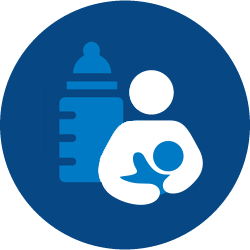Doctors’ Notes
BackBottle-Feeding the Breast-Fed Baby
While babies are born to breastfeed, breastfeeding is a skill that for most families, often takes practice and time to master. Bottle feeding also takes practice, as it’s a completely different mode of food delivery for the breastfed baby.
 We suggest introducing practice bottles around 3 to 4 weeks of age. This will give the family plenty of time to hone breastfeeding skills and establish a good milk supply. Some families may choose to wait longer to introduce that first bottle, but if returning to work is anticipated, practice bottles should begin well before heading back to work. There are many approaches to bottle introduction, but staying consistent with practice is often the best way to help baby accept a bottle.
We suggest introducing practice bottles around 3 to 4 weeks of age. This will give the family plenty of time to hone breastfeeding skills and establish a good milk supply. Some families may choose to wait longer to introduce that first bottle, but if returning to work is anticipated, practice bottles should begin well before heading back to work. There are many approaches to bottle introduction, but staying consistent with practice is often the best way to help baby accept a bottle.
Ideally, expressed milk should be offered in the bottle. This helps keep the taste familiar, and baby continues to reap the benefits of human milk. A strategy that’s often recommended is to have the parent pump after the morning breastfeed and use this milk for later in the day/evening for the practice bottle. Keep in mind that a practice bottle does not need to be a full feed of 3 or 4 oz. Baby can be given a small amount of pumped milk, about ½ to 1 oz., by bottle and can return to the breast to finish feeding.
A slow-flow nipple is a good way to begin with young babies, but what about nipple shape and size? Over the years, various recommendations have been made, such as offering a shorter nipple that transitions into a wide base or offering a longer, tapered nipple. The baby care market is saturated with many different bottles/bottle nipples, which often leads to confusion and unnecessary expense for new families.
There is no one right bottle nipple/bottle for every baby. Experiment with just a few to help determine which your baby likes best. Allow the bottle nipple to gently rest on baby’s upper lip, so baby has control of taking the nipple into their mouth.
Offer the bottle in a relaxed environment and when baby is not overly hungry. Baby should be calm when drinking from the bottle. They shouldn’t guzzle, nor should they take an excessively long time to drink. Keep baby upright, chin off their chest. Never prop a bottle or leave baby unattended while feeding. Pace the feed to mirror the way baby would feed at the breast.
Here’s an excellent video on paced bottle feeding.
Who offers the bottle is often a great debate. Some recommend that mom leave the house, allowing father/partner/grandparent to offer the bottle. Such drastic measures aren’t usually necessary; in fact, some baby experts believe there is no one better suited to offering baby the bottle than the breastfeeding parent. Keeping it low stress and relaxe, and providing baby lots of positive feedback are great strategies to help babies engage in bottle feeding. Enjoy this time with your baby as you learn something new together!
If you need help with getting baby to take a bottle, just give us a call at the Breastfeeding Center of Pittsburgh at 412-246-4726.
Wendy Eson, IBCLC, CEIM, is the Manager of our Breastfeeding Center of Pittsburgh.